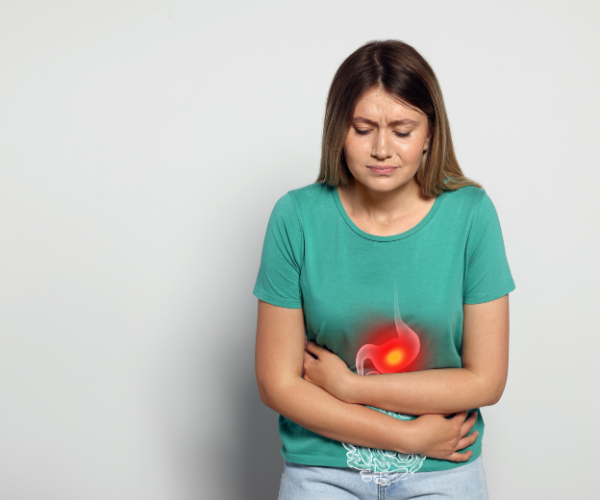The effects of Bimuno® GOS in those prone to functional gastrointestinal issues
More than 40% of individuals worldwide experience functional gastrointestinal disorders (FGDs), such as irritable bowel syndrome (IBS) and functional dyspepsia (Fikree and Byrne., 2021). Diarrhoea, constipation, bloating and nausea are just some of the symptoms associated with such conditions, and despite their detrimental effect on quality of life (QoL), no organic cause can be found, creating a challenge in terms of management (Fikree and Byrne., 2021). As more is being discovered about these conditions, it is thought that changes in gut sensitivity, motility and the gut barrier function could be involved in their development (Wei et al., 2021). Importantly, these functions can be influenced by the gut microbiome and as such, could be a key target in the management, and possibility even prevention, of these conditions (Geng et al., 2022).
Role of the gut microbiome
Research shows that the composition of the gut microbiota is important in human health and can influence many areas of wellbeing. What constitutes as an optimal microbial profile is highly individual, however, a higher proportion of certain species of bacteria, such as those belonging to the Bifidobacterium and Lactobacillus genera, are associated with positive effects on wellbeing (Yang et al., 2020). In the case of FGDs, these conditions are associated with a microbial signature with lower levels of beneficial bacteria and higher levels of potentially pathogenic bacteria, such as species belonging to the Enterobacter genus (Wang et al., 2020; Wei et al., 2021). This imbalance is known as ‘dysbiosis’ and can have a profound effect on the development of health conditions (Carding et al., 2015). Therefore, interventions to modulate the composition of the gut microbiota and increase levels of beneficial bacteria could offer another way to manage symptoms and reduce the impact FGDs have on QoL.
The gut microbiota can be affected by many
factors, including lifestyle-related factors that can be modified, such as
diet, sleep and stress, but also by genetics and age (Hasan and Yang., 2019). When
looking specifically at nutrition, a key food component essential not only for gastrointestinal
health, but also for a functioning gut microbiota, is dietary fibre. Dietary fibre
is a type of indigestible carbohydrate that has been shown to contribute
towards bowel regularity and motility (Cronin et al., 2021). In regard to the
gut microbiota, dietary fibre can contribute to a more diverse composition of
microbes (British Dietetic Association., 2021). In particular, prebiotic fibre has
been shown to stimulate the growth of beneficial bacteria and support a
favourable balance of microbes in the gut (Lockyer and Stanner., 2019).
Evidence using prebiotics
In
2018, Vulevic and colleagues conducted a double-blind, placebo controlled,
crossover study looking at the effects of Bimuno® GOS on functional
gastrointestinal symptoms such as bloating, abdominal pain and flatulence. 83
patients with more than a 75% probability of having FGDs were recruited and split
at random into two groups. Each group followed a 7-week protocol, consisting of
1-week of gastrointestinal and mood symptom screening, followed by 2-weeks
consuming either Bimuno GOS® (2.75g (1.37g active GOS)) or placebo
(maltodextrin) and a 2-week wash-out period, before switching to the opposite
treatment for the final 2-weeks. Supplementation with Bimuno GOS® resulted in
significant reductions in abdominal pain, flatulence and bloating from baseline
and placebo at the end of the first week, with the effect sustained into the
second week (Vulevic et al., 2018). This research adds to a body of evidence suggesting
that modulating the gut microbiota to increase levels of beneficial bacteria
could serve as a potential route to minimise the impact of FGDs.
Read the full open access paper here:
Vulevic, J., Drakoularakou, A., Yaqoob, P., Tzortzis, G. and Gibson, G. (2008). Modulation of the fecal microflora profile and immune function by a novel trans-galactooligosaccharide mixture (B-GOS) in healthy elderly volunteers. The American Journal of Clinical Nutrition, [online] 88(5), pp.1438–1446. Available at:https://ajcn.nutrition.org/article/S0002-9165(23)23376-6/fulltext.
References
British Dietetic Association (2021). Fibre. [online] www.bda.uk.com. Available at: https://www.bda.uk.com/resource/fibre.html.
Carding, S., Verbeke, K., Vipond, D.T., Corfe, B.M. and Owen, L.J. (2015). Dysbiosis of the gut microbiota in disease. Microbial Ecology in Health & Disease, [online] 26(0). Available at: https://www.ncbi.nlm.nih.gov/pmc/articles/PMC4315779/.
Cronin, P., Joyce, S.A., O’Toole, P.W. and O’Connor, E.M. (2021). Dietary Fibre Modulates the Gut Microbiota. Nutrients, [online] 13(5), p.1655. Available at: https://www.ncbi.nlm.nih.gov/pmc/articles/PMC8153313/ [Accessed 29 Nov. 2023].
Fikree, A. and Byrne, P. (2021). Management of functional gastrointestinal disorders. Clinical Medicine, [online] 21(1), pp.44–52. Available at: https://www.ncbi.nlm.nih.gov/pmc/articles/PMC7850201/ [Accessed 27 Nov. 2023].
Geng, Z.-H., Zhu, Y., Li, Q.-L., Zhao, C. and Zhou, P.-H. (2022). Enteric Nervous System: The Bridge Between the Gut Microbiota and Neurological Disorders. Frontiers in Aging Neuroscience, [online] 14. Available at: https://www.ncbi.nlm.nih.gov/pmc/articles/PMC9063565/ [Accessed 30 Aug. 2022].
Hasan, N. and Yang, H. (2019). Factors affecting the composition of the gut microbiota, and its modulation. PeerJ, [online] 7, p.e7502. Available at: https://www.ncbi.nlm.nih.gov/pmc/articles/PMC6699480/.
Lockyer, S. and Stanner, S. (2019). Prebiotics – an added benefit of some fibre types. Nutrition Bulletin, [online] 44(1), pp.74–91. Available at:https://onlinelibrary.wiley.com/doi/full/10.1111/nbu.12366.
Vulevic, J., Tzortzis, G., Juric, A. and Gibson, G.R. (2018). Effect of a prebiotic galactooligosaccharide mixture (B-GOS®) on gastrointestinal symptoms in adults selected from a general population who suffer with bloating, abdominal pain, or flatulence. Neurogastroenterology & Motility, [online] 30(11). Available at: https://onlinelibrary.wiley.com/doi/full/10.1111/nmo.13440.
Wang, L., Alammar, N., Singh, R., Nanavati, J., Song, Y., Chaudhary, R. and Mullin, G.E. (2020). Gut Microbial Dysbiosis in the Irritable Bowel Syndrome: A Systematic Review and Meta-Analysis of Case-Control Studies. Journal of the Academy of Nutrition and Dietetics, [online] 120(4), pp.565–586. Available at: https://www.sciencedirect.com/science/article/pii/S2212267219304721.
Wei, L., Singh, R., Ro, S. and Ghoshal, U.C. (2021). Gut Microbiota Dysbiosis in Functional Gastrointestinal disorders: Underpinning the Symptoms and Pathophysiology. JGH Open, [online] 5(9). Available at: https://onlinelibrary.wiley.com/doi/full/10.1002/jgh3.12528 [Accessed 28 Nov. 2023].
Yang, Q., Liang, Q., Balakrishnan, B., Belobrajdic, D., Feng, Q.-J. and Zhang, W. (2020). Role of Dietary Nutrients in the Modulation of Gut Microbiota: A Narrative Review. Nutrients, [online] 12(2), p.381. Available at: https://www.mdpi.com/2072-6643/12/2/381 [Accessed 22 Mar. 2024].
